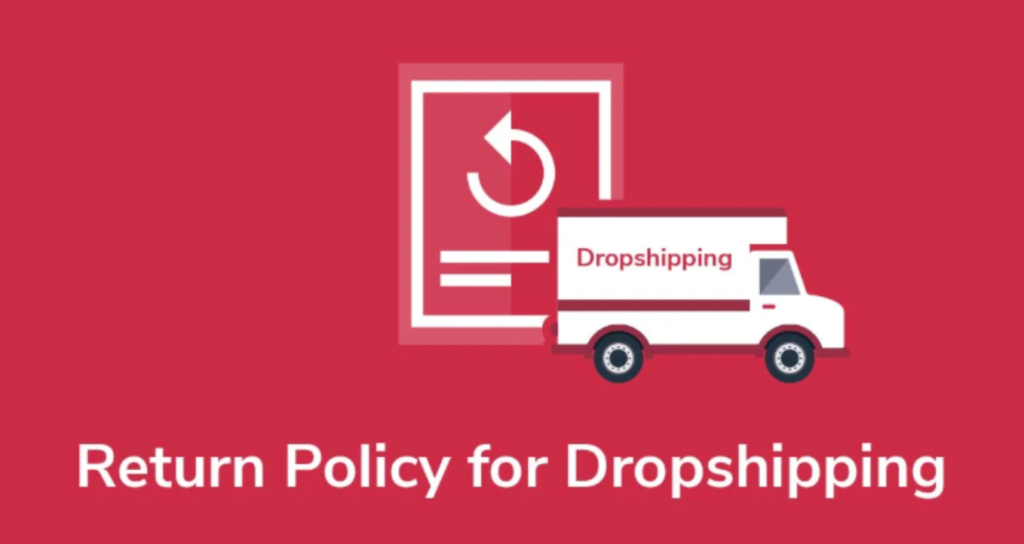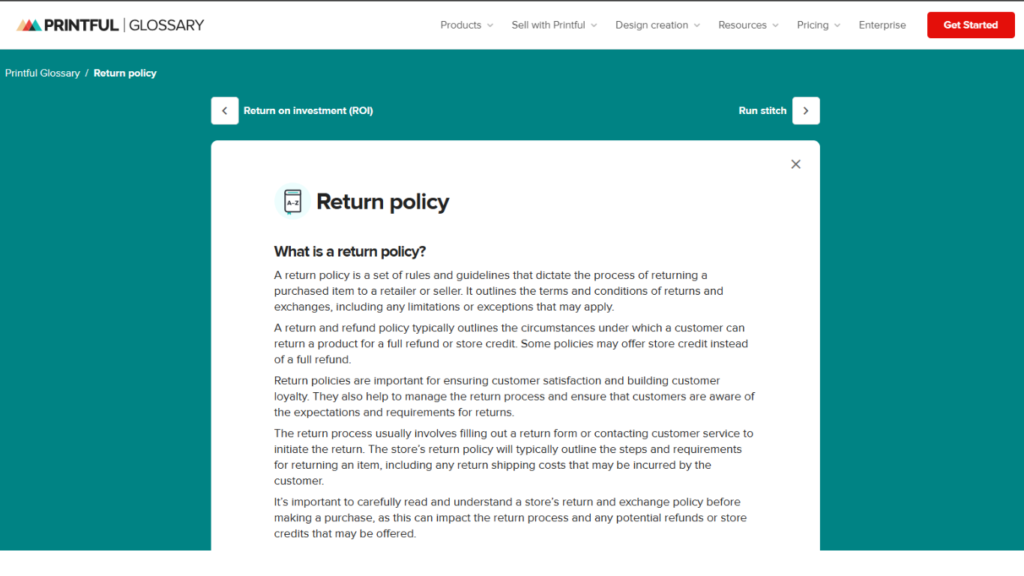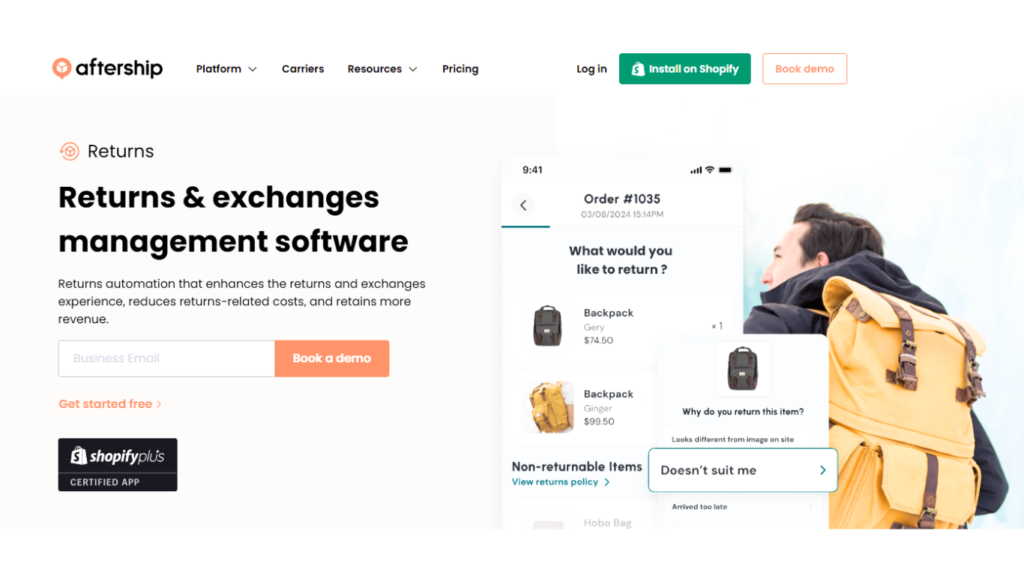Are dropshipping returns and refunds draining your profits and damaging your reputation?
If you’re running a dropshipping business, you already know that managing returns isn’t as simple as traditional ecommerce business. You’re dealing with third-party dropshipping suppliers, unpredictable policies, and frustrated customers—all of which can lead to negative reviews and lost revenue.
Did you know that over 30% of all online purchases end in a return?
Yet, most dropshipping businesses fail to implement an effective return strategy, leading to costly mistakes. The difference between a thriving ecommerce store and one that struggles often comes down to how well return management system are handled. Without a solid system in place, you risk losing customer trust, increasing chargebacks, and even getting your payment accounts suspended.
Imagine a business where returns are streamlined, customer loyalty trust is high, and refunds don’t eat into your dropshipping profit margins. With the right policies and strategies, you can minimize losses, prevent fraudulent returns, and even turn returns into repeat business.
By mastering your dropshipping returns and refunds process, you’ll gain a competitive edge, improve customer satisfaction, and increase long-term profitability.
In this guide, you’ll learn:
-
Why a transparent return policy is crucial for your dropshipping success.
-
The most common reasons for returns (and how to reduce them).
-
A step-by-step process for handling returns efficiently.
-
Proven strategies to minimize return costs and prevent fraud.
-
The legal requirements for returns in different regions.
-
How technology can automate and improve your returns process.
Ready to take control of your dropshipping returns?
Let’s dive in and set your dropshipping store business up for long-term success!
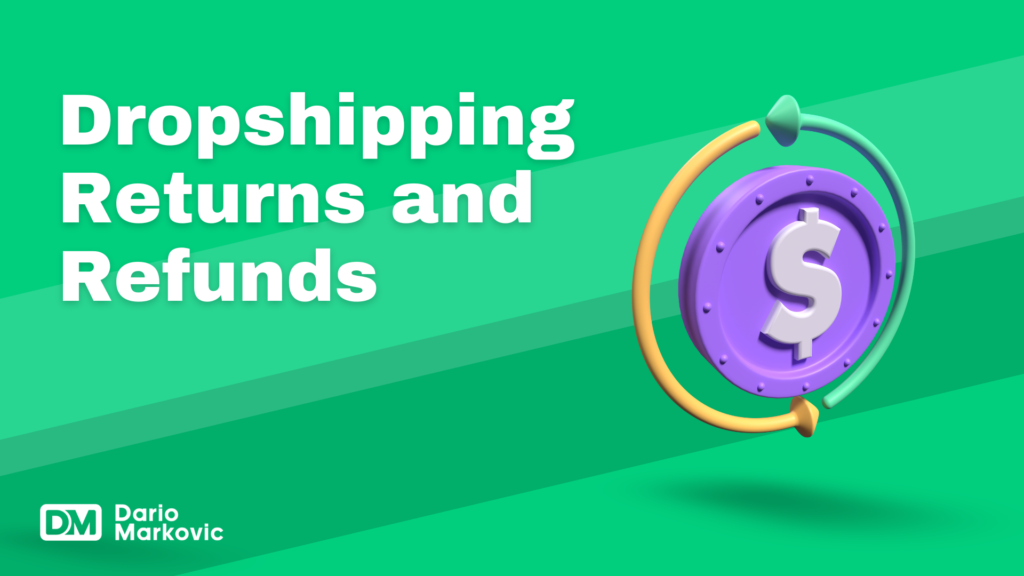
Understanding Dropshipping Return Policies
Creating a return policy that is both clear and concise is essential for building customer trust and confidence. Customers need to know exactly what to expect if they are unsatisfied with their purchase, including the conditions for accepting returns.
A transparent policy can mitigate potential disputes and foster a positive online shopping experience.
Aligning your return policy with your suppliers’ policies is crucial to ensure a smooth processing of returns. If there’s a mismatch between what you promise your customers and what your suppliers can deliver, you risk delays, increased costs, and unhappy customers.
Key components to include in a well-crafted dropshipping return policy:
-
Timeframes: Specify the period within which customers can initiate a return. Common timeframes range from 14 to 30 days after receiving the product.
-
Conditions for Returns: Define what qualifies as a valid return. This might include criteria like unused items, original packaging, or specific reasons such as defects or incorrect wrong items.
-
Return Process: Outline the steps customers need to follow. This typically involves contacting customer service, obtaining a Return Merchandise Authorization (RMA), and return instructions for shipping the wrong item back.
Having these elements in place not only streamlines the return process but also demonstrates professionalism and reliability to your customers.
What is Dropshipping?
Dropshipping is a popular eCommerce business model that allows entrepreneurs to run an online business store without holding excess inventory.
Instead of stocking products, the store partners with best dropshipping suppliers who handle storage, packaging, and shipping.
When a customer places an order, the seller purchases the item from a third-party supplier, who then ships it directly to the customer.
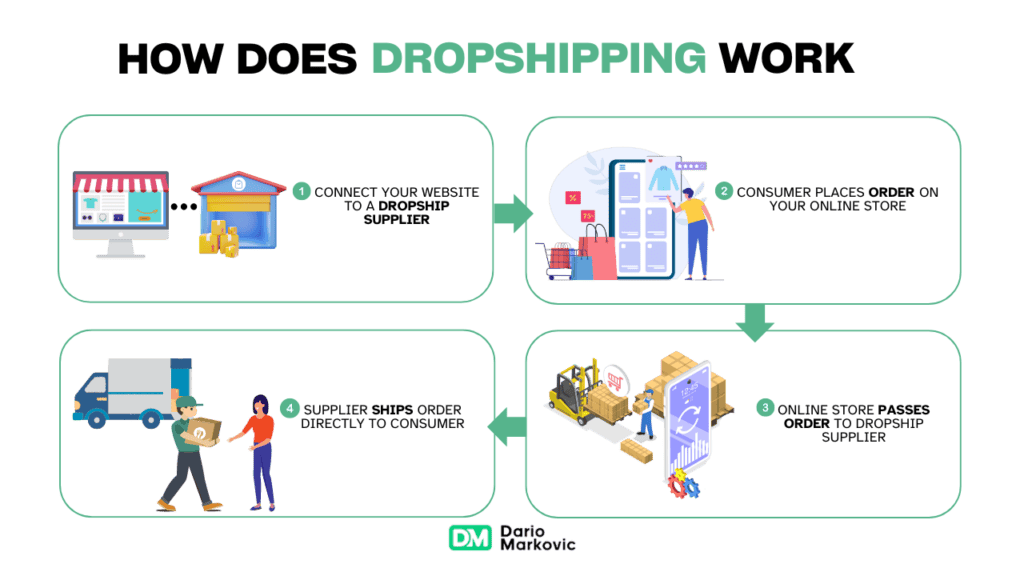
This dropshipping business model is an attractive ecommerce model because it minimizes upfront costs, eliminates the need for warehouse space, and reduces financial risk. By focusing on marketing and sales, business owner can scale their businesses quickly without being burdened by logistics.
However, while dropshipping offers convenience, it also comes with challenges—particularly when it comes to handling dropshipping returns and managing customer expectations.
Since dropship returns require coordination between the seller and supplier, it’s essential to have a well-defined return process. A Shopify store dropshipping return policy or any online store return policy should clearly outline the conditions for returns, who covers the return shipping costs, and how refunds are processed.
Without an efficient return policy, customers may lose trust in your store, leading to chargebacks and negative reviews.
By understanding how dropshipping suppliers operate and implementing a return process that aligns with their policies, you can streamline returns and improve customer satisfaction.
Now, let’s explore the common reasons why customers return products in dropshipping stores and how you can minimize return rates.
Common Reasons for Returns and Refunds in Dropshipping
Understanding why customers return products is crucial to managing dropshipping returns effectively. When an order does not meet the customer’s expectations—whether due to damage, wrong items, or errors in fulfillment—customers are more likely to initiate return requests, emphasizing the importance of having a clear return policy in place.
Here are some frequent causes:
1. Mismatched Product Descriptions
One of the common reasons for returns in dropshipping is mismatched product descriptions. Customers often receive items that don’t match the online description or images, leading to dissatisfaction and return requests.
2. Sizing Issues
Especially prevalent in niches like clothing and footwear, sizing issues can be a major headache. Customers may find that the items they receive do not fit as expected, prompting them to seek refunds or exchanges.
3. Defective Items
Product quality issues are another significant factor. Items arriving damaged or defective compel customers to initiate returns, often leading to a customers request for a return due to these issues.
This not only affects customer satisfaction but also impacts your business reputation.
4. Shipping Delays
The impact of shipping delays on customer satisfaction cannot be overstated. Delayed shipments can lead to frustration and impatience, increasing the likelihood of receiving return requests.
“I ordered this a month ago, and it just arrived!”
Brian Keller
5. Buyer's Remorse
Psychological factors like buyer’s remorse also play a role in returns.
After making a purchase, customers may regret their decision for various reasons such as financial concerns or simply changing their mind.
Research indicates that addressing these common reasons for returns involves maintaining accurate product descriptions, ensuring quality control, managing shipping expectations, and providing excellent customer service to mitigate buyer’s remorse source.
How to Deal with Returns in Dropshipping?
Handling dropshipping returns efficiently is crucial for maintaining customer satisfaction and protecting your business from financial losses.
Whether you run a Shopify store dropshipping store or any other online business store, dealing with returns can be complex due to third-party suppliers.
Check out this Video on how to deal with Returns in Dropshipping here.
Here’s a strategic approach to managing returns:
1.Establish a Clear Shopify Dropshipping Return Policy
Your dropshipping business model must include a transparent return policy. Define conditions for returns, acceptable timeframes, and whether you or the customer will cover shipping fees.
Where:
-
Website banner
-
Order notification emails
-
Website chat
-
Your website footer

2. Choose Reliable Dropshipping Suppliers
Not all dropshipping suppliers offer return options. Partnering with those who have clear return policies ensures a smoother return process for both you and your customers.
For example Printful (for Print on Demand) offers a clear return policy for damaged or incorrect items. They provide a full refund or replacement in case of an issue with the product.
3. Automate Your Returns Process
Using return management tools integrated into your dropshipping store can simplify handling returns, issuing RMAs, and tracking refunds.
To automate the returns for your dropshipping store, one useful tool is Aftership.
4. Prevent Returns with Quality Control
Reduce dropship returns by
-
Accurate Product Descriptions: Provide detailed and honest descriptions to set proper customer expectations.
-
High-Quality Images: Use clear, high-resolution images from multiple angles to show the product in detail.
-
Clear Sizing Charts: Offer precise sizing information, especially for apparel, to help customers choose the right fit.
5. Handle Refunds Promptly
A structured return process that prioritizes
-
Clear Return Policy: Clearly communicate your return and refund policies on your website to set expectations.
-
Efficient Process: Streamline the return process to make it easy for customers to request a refund or exchange.
-
Quick Response: Prioritize timely responses to refund requests and aim to process refunds as quickly as possible.
-
Customer Communication: Keep customers informed throughout the process to build trust and ensure satisfaction.
By implementing these strategies, you can streamline your dropshipping returns while keeping your customers happy and your business profitable.
Creating a Return Policy
Creating a return policy is essential for any online store, especially those that use the dropshipping business model. A return policy outlines the procedures and guidelines for customers to return products, and it helps to build trust and confidence with customers.
A well-crafted return policy should include key elements such as the return window, return shipping costs, and the process for initiating a return.
A clear and comprehensive return policy not only sets customer expectations but also ensures a smooth return process. It provides customers with the necessary information on how to return products, what conditions must be met, and how refunds will be processed.
This transparency can significantly enhance customer satisfaction and loyalty, which are crucial for the success of any dropshipping business.
Key Elements of a Return Policy
A return policy should include the following key elements:
-
Return Window: Specify the time frame within which customers can initiate a return. This period typically ranges from 14 to 30 days after the product is received.
-
Return Shipping Costs: Clearly state who is responsible for paying the return shipping fees. This could be the customer, the online store, or the dropshipping supplier.
-
Return Process: Outline the steps customers need to take to initiate a return. This includes contacting customer service, obtaining a Return Merchandise Authorization (RMA), and instructions for shipping the item back.
-
Refund Policy: Detail how refunds will be processed, including the method of refund (e.g., credit card, store credit) and any applicable restocking fees.
-
Exceptions: List any exceptions to the return policy, such as final sale items or products that cannot be returned due to hygiene reasons.
By including these elements, you ensure that your return policy is comprehensive and easy to understand, which can help prevent misunderstandings and disputes.
Step-by-Step Guide for the Return Process in Dropshipping
Understanding the dropshipping return process and the refund process in dropshipping is essential for maintaining customer satisfaction and operational efficiency.
Here’s a detailed breakdown of each stage involved:
1. Customer Initiates Return Request
-
Customers initiate a refund request by contacting the seller via the designated return channels (email, website form, etc.).
-
They provide details such as order number, reason for return, and any supporting evidence (e.g., photos of defective items).
2. Seller Reviews Return Request
The seller assesses the return and refund requests to ensure they meet the return policy criteria.
If valid, the seller issues a Return Merchandise Authorization (RMA) number, a unique identifier that tracks the returned item throughout the process.
3. Customer Returns the Item
-
Customers are instructed to send the product back using a provided shipping label or at their own expense.
-
Including the RMA number on the package helps streamline processing upon arrival.
4. Supplier Receives and Inspects Return
-
The supplier receives the returned item and checks it against the RMA details.
-
They confirm whether it meets their return conditions (e.g., unworn, tags attached).
5. Refund or Replacement Processed
-
Once approved by the supplier, they notify the seller of the inspection result.
-
The seller then processes a refund or ships a replacement item to the customer.
Maintaining clear communication throughout this process is crucial. Here’s why:
-
Transparency: Keeping customers informed about each step helps build trust.
-
Efficiency: Clear instructions reduce misunderstandings and delays.
-
Prompt updates reassure customers that their concerns are being addressed.
Without effective management of this multi-step process, both customer satisfaction and operational efficiency can suffer.
What is Return Merchandise Authorization (RMA)?
A Return Merchandise Authorization (RMA) is a unique code or number assigned to a return request. It is used to track and process returns, ensuring that returns are handled efficiently and effectively. An RMA is typically required for customers to initiate a return, and it is usually provided by the online store or supplier.
The RMA process helps streamline the returns process by providing a systematic way to manage and track returns. When a customer sends requests a return, they are issued an RMA number, which they must include with the returned item. This number helps the online store and the dropshipping supplier identify the return address and process it accordingly.
By using RMAs, you can ensure that returns are processed quickly and accurately, reducing the likelihood of errors and delays.
Here is an example from TermsFeed:
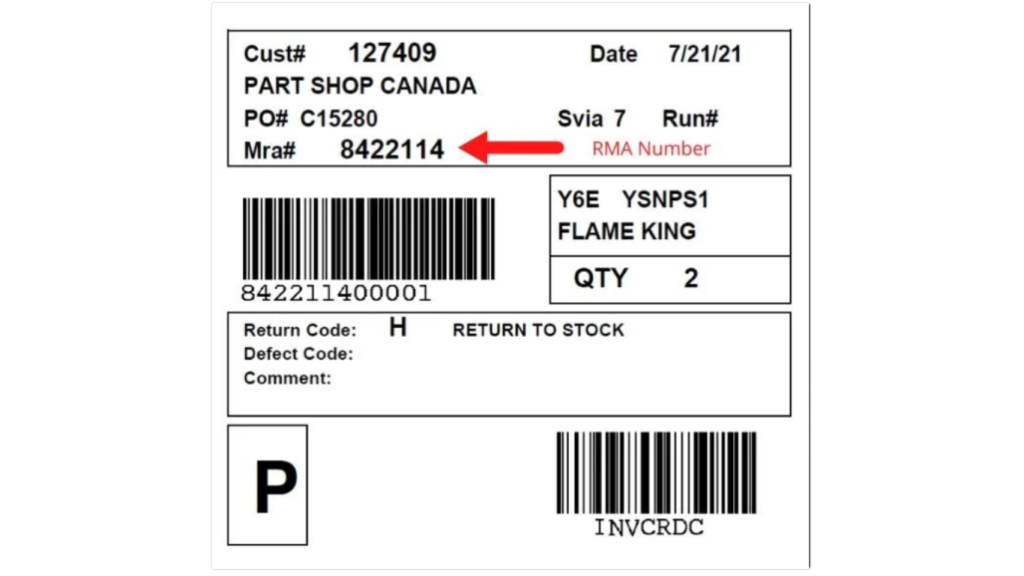
Cost Management Strategies for Handling Returns in Dropshipping
Handling returns efficiently in dropshipping is essential to maintain profitability. One critical aspect is deciding who bears the return shipping costs. Some sellers opt to cover return shipping fees to enhance customer satisfaction, while others pass the expense on to the customer.
Restocking Fees
Implementing restocking fees can deter excessive returns, but it’s crucial to balance this with customer experience.
High restocking fees might discourage future purchases, whereas reasonable fees can help recover some handling costs without alienating customers.
Cost-Effective Alternatives
Offering replacements instead of full refunds can be a savvy approach. Replacements often cost less than processing refunds and can improve customer satisfaction by resolving their issues promptly.
Evaluating these strategies helps manage refunds in dropshipping effectively, ensuring both customer satisfaction and business sustainability.
Who Pays for Return Shipping?
The question of who pays for return shipping is an important one, and it should be clearly outlined in the return policy.
In some cases, the customer may be responsible for paying for return shipping, while in other cases, the online store or supplier may cover the cost. It is essential to consider the customer’s expectations and the cost of return shipping when determining who pays for return shipping.
Offering free returns or covering the cost of return shipping can help to build trust and confidence with customers, but it can also eat into profit margins.
Therefore, it’s crucial to strike a balance between customer satisfaction and maintaining healthy profit margins. Some online stores choose to cover return shipping costs for defective or incorrect items, while requiring customers to pay for return shipping on other types of returns.
This approach can help manage costs while still providing a positive customer experience.
Fraud Prevention Techniques
Fraudulent returns can be a significant challenge in the dropshipping industry. Customers sometimes exploit lenient return policies to obtain free products or refunds without valid reasons. Identifying these risks early helps mitigate potential losses and maintain the integrity of your business.
Common Risks in Dropshipping Returns
Common risks include:
-
False Claims: Customers might claim items are defective or not received when they have indeed received them in good condition.
-
Wardrobing: This involves customers buying items, using them briefly, and then returning them for a full refund.
-
Return Abuse: Some customers habitually abuse return policies by frequently purchasing and returning items.
Proactive Measures to Reduce Fraud
Implementing proactive measures can significantly reduce fraud:
-
Address Verification Systems: Ensure the addresses provided by customers are legitimate before approving a return request. This helps to verify that the product was indeed delivered to the right location.
-
Evidence Requirement: Ask customers to provide evidence, such as photos or videos of the damaged or defective product, before accepting a return request. This step ensures that claims of defects are genuine.
-
Detailed Fraud Policy: Clearly outline your fraud prevention policies on your website. Inform customers that fraudulent activities will be reported and legal action may be taken if necessary.
By integrating these techniques into your dropshipping operations, you can protect your business from return scams while maintaining positive customer service for returns.
Leveraging Technology: Automating Your Returns Process for Efficiency
Embracing technology can change how you manage returns in your dropshipping business.
Automation tools make various parts of your returns process smoother, greatly cutting down on manual work and mistakes.
Benefits of Using Automation Tools:
-
Generating Shipping Labels: Automation software can automatically create and send shipping labels to customers who initiate a return, saving time and ensuring accuracy.
-
Tracking Returned Items: Tools like Return Magic or AfterShip automate the tracking of returned items, providing real-time updates to both you and your customers. This transparency is crucial for maintaining trust.
-
Centralized Returns Management: Platforms such as Returnly or Loop Returns offer comprehensive solutions that integrate with your e-commerce system, helping you manage all returns from a single dashboard.
-
Automated Communication: Automated emails and notifications keep customers informed at each step of the return process, enhancing their overall experience and reducing the workload on your customer service team.
Read More: 5 Best Dropshipping Automation Tools to Streamline Your Business
Incorporating these technologies aligns with having an effective return policy. By leveraging automation, you ensure a seamless and efficient returns process that boosts customer satisfaction and operational efficiency.
Legal Compliance and Consumer Rights
Dropshipping businesses face unique challenges when it comes to selecting reliable dropshipping suppliers and ensuring legal compliance, especially across different jurisdictions.
Failing to adhere to international return policies can lead to penalties and damage customer trust, which is why understanding these regulations is crucial.
Key Considerations for Legal Compliance
1. Jurisdiction-Specific Laws
Different countries have varying laws regarding consumer rights and returns. For instance, the European Union mandates a 14-day “cooling-off” period during which customers can return items without providing a reason. In contrast, U.S. regulations may vary by state but often require clear disclosure of return policies.
2. Mandatory Refunds
Some regions require mandatory refunds for specific conditions such as defective products or items not matching their descriptions. It’s essential to be aware of these stipulations to avoid legal complications.
3. Transparency
Clearly communicating your return policy helps build customer confidence. Make sure your policy details timeframes, conditions for returns, and the steps customers need to follow.
Best Practices for Ensuring Compliance
-
Align with Suppliers: Ensure that your suppliers’ return policies are compatible with local laws in the markets you serve. Any discrepancies can lead to delays and customer dissatisfaction.
-
Documentation: Keep records of all transactions and communications related to returns. This documentation can serve as evidence in case of disputes or legal inquiries.
-
Legal Counsel: Consulting with legal experts can provide invaluable insights into navigating complex international laws. This step ensures that your business remains compliant across all operational territories.
By paying careful attention to international return policies and maintaining legal compliance, dropshipping businesses can foster global customer trust while avoiding penalties.
Key Considerations for Successfully Handling Dropshipping Returns
While implementing a strong return policy and following a clear return process are crucial, there are additional factors to consider to optimize your return management strategy.
First, maintaining good relationships with your dropshipping suppliers can significantly impact how efficiently returns are handled. Some suppliers have strict policies, while others may offer more flexibility. Choosing suppliers with return-friendly policies can reduce complications and improve your overall return experience.
Additionally, clear communication with customers is essential. Providing transparent updates about return timelines, refund processing, and shipping expectations can reduce frustration and improve customer satisfaction. Automating these communications through email sequences or chatbots can make the process smoother and more professional.
Lastly, tracking return data can help you identify patterns in returns, allowing you to make informed decisions on improving product descriptions, quality control, and customer expectations.
By consistently refining your return management strategy, you can reduce return rates and improve overall business efficiency.
Taking It to the Next Level: How to Optimize Dropshipping Returns
Beyond simply managing returns, advanced strategies can enhance your return process and reduce return rates altogether.
-
Proactive Quality Control – Work closely with multiple suppliers to ensure that products meet quality standards before being shipped. This reduces returns due to defects or mismatched expectations.
-
Flexible Return Options – Consider offering store credit instead of refunds to retain revenue and encourage repeat purchases. Customers who receive store credit are more likely to buy again.
-
Automated Return Management – Utilize return automation tools like Returnly, AfterShip, or Loop Returns to streamline return approvals, generate shipping labels, and process refunds faster.
By implementing these enhancements, you can reduce return rates, improve profitability, and create a more seamless experience for customers.
Read More: 5 Best Dropshipping Automation Tools to Streamline Your Business
Alternatives to Traditional Dropshipping Returns
While managing returns is an essential part of running a dropshipping business, there are alternative approaches to handling returns that may be more cost-effective:
-
No-Return Refunds – Some dropshipping stores opt to issue refunds without requiring a return, especially for low-cost items. This saves on shipping costs and improves customer goodwill.
-
Resell or Donate Returned Items – Instead of absorbing a loss, some businesses resell returned items at a discount or donate them to charities, creating goodwill and reducing waste.
-
Outsource Returns Handling – Some companies partner with third-party returns management services that handle inspection, repackaging, and reselling, freeing you from logistical headaches.
Exploring these alternatives can help reduce costs, improve efficiency, and create a more customer-friendly return experience.
My Experience with Dropshipping Returns and Refund
Having worked extensively in dropshipping, I’ve seen firsthand how poorly managed returns and refunds can impact a business. Early on, I struggled with supplier miscommunications, unclear return policies, and frustrated customers.
These issues led to charge restocking fees, bad reviews, and revenue loss—problems that could have been avoided with a well-structured return process.
Through experience, I learned the importance of choosing reliable suppliers, implementing automated return solutions, and setting clear return policies that align with both customer expectations and supplier capabilities.
By refining these processes, I was able to reduce return rates, improve customer satisfaction, and streamline operations—turning returns from a liability into a competitive advantage.
If you’re looking to optimize your dropshipping business, following these strategies will help you avoid common pitfalls and build a profitable, sustainable store.
Keep learning, stay adaptable, and always put customer experience at the core of your business decisions.
FAQ
The return rate for dropshipping varies depending on the niche, product quality, and supplier policies. On average, return rates range between 10% and 30%, with fashion and electronics typically seeing higher return rates.
Clear refund policies and quality control can help minimize returns.
The average profit margin in dropshipping is typically between 10% and 30% after accounting for product costs, marketing expenses, and transaction fees.
Successful dropshippers often focus on high-demand, high-margin products to maximize returns.
Yes, dropshippers do handle returns, but the process depends on the supplier’s policies. Some suppliers allow returns, while others may offer refunds or replacements without requiring the product to be sent back.
It’s essential to choose reliable suppliers with a clear return policy to maintain customer satisfaction.
Dropshipping can be highly profitable when managed correctly. Profitability depends on factors like product selection, marketing strategies, and supplier costs. While some dropshippers earn a few hundred dollars per month, others scale their businesses to six or seven figures annually. Success requires consistent effort, testing, and optimization.
Some of the most successful dropshippers include Sebastian Ghiorghiu, Alex Becker, and Kevin Zhang, who have reportedly made millions through eCommerce and dropshipping. These entrepreneurs leveraged branding, automation, and digital marketing strategies to scale their businesses profitably.
Celebrities play a significant role in C2B marketing, as they are often paid to promote products through their social media channels.

